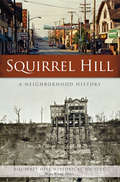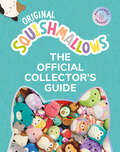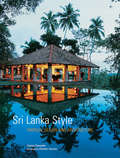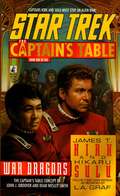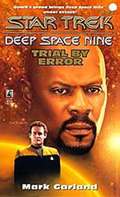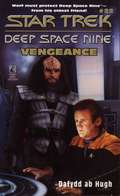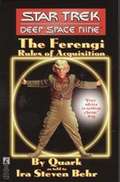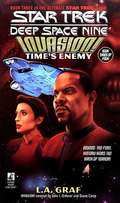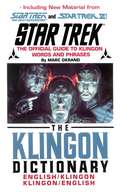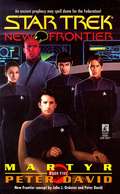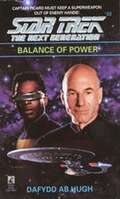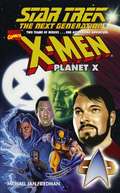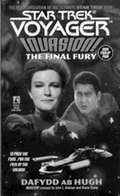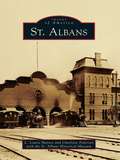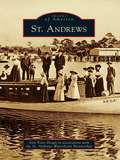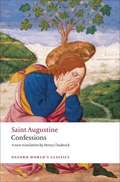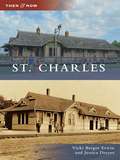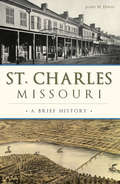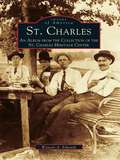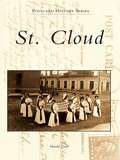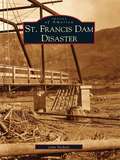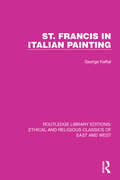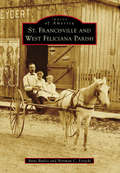- Table View
- List View
Squirrel Hill: A Neighborhood History (American Chronicles)
by Editor Helen Wilson Squirrel Hill Historical SocietyPittsburgh’s Squirrel Hill neighborhood began on the frontier of western Pennsylvania 250 years ago and developed into a vibrant urban community. Early settler John Turner, half brother of renegade Simon Girty, survived capture by Native Americans and experienced firsthand the change from dangerous wilderness to established farming community. Wealthy landowners Henry Clay Frick and Mary Schenley bestowed Squirrel Hill its grand public parks. Hyman Little, Herman Kamin and countless others moved to the hill and made it Pittsburgh’s premier Jewish community, with a tightknit cluster of synagogues, temples and a thriving business district. The Squirrel Hill Historical Society and editor Helen Wilson explore the fascinating history of one of Pittsburgh’s historic neighborhoods.
Squishmallows: The Official Collector's Guide
by Bernie CollinsBased on the #1 plush property, this NEW Squishmallows Official Collector’s Guide is the perfect gift for any fan!They're lovable, they’re ultra-soft—they're Squishmallows! This OFFICIAL Collector's Guide is packed with fun facts, top-ten lists, Squishmallows’ bios & stats, a rarity guide, and hundreds of colorful photos and unique art styles. Whether you’re already an avid collector or new to the Squishmallows Squad, this Collector’s Guide is perfect for fans of all ages!Since Squishmallows debuted in 2017, each plush has featured its own lovable personality and have become known for their ultra-soft feel and whimsical design that have captivated fans of all ages, both online and in person. More than 1,000 Squishmallows ranging from two to twenty-four inches in size have gained the attention of bona fide Squishmallows fans in more than 40 countries.
Sri Lanka Style
by Dominic Sansoni Channa DaswatteSri Lanka Style showcases over 30 of the finest traditional and modern dwellings in Sri Lanka, from private homes to retreats and resorts, all designed by the island's most creative architects and interior designers including some by the world-renowned architect Geoffrey Bawa that have never been seen before. These houses demonstrate the essentials of the Sri Lankan lifestyle-spaces open to the environment and the natural use of space and decor-and contribute to a palpable sense of peace and discipline. In addition, there are practical design ideas that can be applied to any tropical locale.
St Ct #1 War Dragons: The Captain's Table (Star Trek #Bk.1)
by L A GrafThere's a bar called "The Captain's Table," where those who have commanded mighty vessels of every shape and era can meet, relax, and share a friendly drink or two with others of their calling. Sometimes a brawl may break out but it's all in the family, more or less. Just remember, the first round of drinks is always paid for with a story...even beyond the final frontier. Captain James T. Kirk must join forces with Captain Hikaru Sulu, new commander of the U.S.S. Excelsior,to resolve a simmering political situation in a distant star system. For more than twenty years, the ancient enmity between Nykkus and Anjiri has resisted the best efforts of Federation diplomats. Now Kirk and Sulu have one last chance to end the bloodshed -- before it erupts into a full-scale interstellar war!
St Ds9 #21 Trial By Error (Star Trek #21)
by Mark GarlandWhen Quark brokers a lucrative deal to trade trellium crystals from the Gamma Quadrant for gold-pressed latinum, the potential for profit seems too good to be true. It is. Pretty soon, Deep Space Nineis under fire from at least three different alien races, each accusing the others of theft, piracy, and worse. Then, angry Klingons get involved, and so do the Ferengi... Odo wouldn't mind seeing one of Quark's schemes backfire, but not when it places the entire station in the middle of a shooting war that might consume them all!
St Ds9 #22 Vengeance (Star Trek #22)
by Dafydd Ab HughRumors of a secret alliance between the Dominion and the Klingon Empire lure Captain Sisko and the crew of the Defiant on a desperate mission into the Gamma Quadrant, leaving Deep Space None vulnerable to a surprise sneak attack! Now an elite Klingon task force has seized control of the station, and only Chief O'Brient, Dr. Bashir, and Worf are left to defend Deep Space Nine. But Worf's loyalties are tested when he discovers that the invaders include his oldest friend -- and his own brother!
St Ds9 Ferengi Rule Of Acquisition (Star Trek)
by Ira Steven BehrThe Ferengi are greedy, avaricious, ruthless, cowardly and completely unscrupulous. For centuries the famous Ferengi Rules of Acquisition have been the guiding principles of the galaxy's most successful entrepreneurs. These 285 Rules of Acquisition range from, #1 "Once you have their money, never give it back." to #21 "Never place friendship before profit." These rules and hundreds more have taken many successful Ferengi to new frontiers of profit.
St Invasion: Book #3 Time's Enemy (Star Trek #16)
by L A GrafThe Federation is threatened by this ancient mystery when a battered and broken version of the Defiantis found, frozen for five thousand years, in an icy cloud of cometary debris. Captain Sisko and the crew of Deep Space NineTMare summoned to answer the most baffling question of their lives: how and when will their ship be catapulted back through time to its destruction? And does its ancient death mean that one of the combatants in a primordial battle is poised now to storm the Alpha Quadrant? Only the wormhole holds the answer -- and the future of the Federation itself may depend on the secrets it conceals.
St Klingon Dictionary: More Than 400 New And Exciting Recipes All Made With 4 Or Fewer Ingredients And All Gluten-free! (Star Trek #Pt. 1)
by Star TrekThe Klingon Dictionary is the first comprehensive sourcebook for Klingon language and syntax, including fundamental rules of grammar as well as words and expressions that illustrate the complex nature of Klingon culture. It features a precise pronunciation guide, rules for proper use of affixes and suffixes, and a small phrasebook with Klingon translations for essential expressions such as ""Activate the transport beam,"" ""Always trust your instincts,"" and the ever-popular ""Surrender or die!""
St New Frontier #5 Martyr: A Novel (Star Trek: The Next Generation #5)
by Peter DavidWith the fall of the ancient Thallonian Empire, civil war threatens the planet of Zondar. The arrival of the U.S.S Excalibur is greeted with relief and celebration by the anxious populace, and Captain Mackenzie Calhoun, fresh from his cataclysmic escape form the Thallonian throneworld, is acclaimed as their prophesied savior. But one believer's messiah is another's blasphemer -- and a prime candidate for martyrdom. When Captain Calhoun is captured, Lieutenant Commander Burgoyne must find him before an alien fleet launched a holy war against the Federation!
St Ng #33 Balance Of Power (Star Trek #No.33)
by Dafydd Ab HughWhen a famous Federation scientist dies, his son puts his inventions up for sale to the highest bidder, be they Federation, Klingon, Romulan, or Cardassian. Among the items at auction is a photon pulse canon capable of punching through a starship's shields with a single shot. Meanwhile, Wesley Crusher is kidnapped from the Academy by renegade Ferengi who have set their sights on the photon canon as well, and Captain Picard must outmaneuver enemies on every side to save Wesley and protect the EnterpriseTM from the deadly fire of the new canon.
St The Next Generation Planet X (Star Trek)
by Michael Jan FriedmanMichael Jan Friedman is the author of nearly sixty books of fiction and nonfiction, more than half of which bear the name Star Trek or some variation thereof. Ten of his titles have appeared on the New York Times bestseller list. He has also written for network and cable television, radio, and comic books, the Star Trek: Voyager® episode ""Resistance"" prominent among his credits. On those rare occasions when he visits the real world, Friedman lives on Long Island with his wife and two sons. He continues to advise readers that no matter how many Friedmans they know, the vast probability is that none of them are related to him.
St Voy Vol #9: Final Fury (Star Trek #9)
by Dafydd Ab HughFor ages they have sought to claim our worlds. Now, at last, we take the battle to them. . . . Far from the Federation's desperate war against the invading Furies, the crew of the U.S.S. VoyagerTM encounters something they never expected to hear again: a Starfleet distress call. The signal leads them to a vast assemblage of non-humanoid races engaged in a monumental project of incredible magnitude. Here is the source of the terrible invasion threatening the entire Alpha Quadrant -- and, for the Starship VoyagerTM, a possible route home. But soon there may not be any home to return to . . .
St. Albans
by St. Albans Historical Museum Charlotte Pedersen L. Louise HaynesMany years after Jesse Welden became the first permanent settler in St. Albans, the town was the site of the northernmost raid by Confederate Civil War soldiers in 1864. St. Albans went on to earn fame as the "Railroad City." Over the years, the commercial base in St. Albans grew, many churches and schools were founded, and there was a sharp increase in population. Because of these many changes, St. Albans transformed from an agricultural community dependent upon Lake Champlain for transportation to the seat of Franklin County.
St. Andrews (Images of America)
by Ann Pratt Houpt St. Andrews Waterfront PartnershipFrom one of the first mentions of St. Andrews by the British in 1771 to the present day, people have long been pulled to the community as an ideal place to live. Around 1880, many years after Native American tribes greeted the first European settlers to St. Andrews, the St. Andrews Bay Railroad, Land and Mining Company summed up this idyllic town in an advertisement for mailorder real estate with this description: "The loveliest location in all Florida . . . the fairest land the sun ever blessed with its genial kiss. There is but one Florida, and St. Andrews Bay is its brightest jewel." Many settlers lured by advertising such as this came to visit and found they wanted to stay. After St. Andrews incorporated in 1908, the community began its transformation into the popular port it is today.
St. Anne in Renaissance Music
by Michael Alan AndersonDevotion to Saint Anne, the apocryphal mother of the Virgin Mary, reached its height in the fifteenth and early sixteenth centuries. Until now, Anne's reception history and political symbolism during this period have been primarily discussed through the lens of art history. This is the first study to explore the music that honoured the saint and its connections to some of the most prominent court cultures of western Europe. Michael Alan Anderson examines plainchant and polyphonic music for Saint Anne, in sources both familiar and previously unstudied, to illuminate not only Anne's wide-ranging intercessional capabilities but also the political force of the music devoted to her. Whether viewed as a fertility aide, wise mother, or dynastic protector, she modelled a number of valuable roles that rulers reflected in the music of their devotional programmes to project their noble lineage and prestige.
St. Augustine's Confessions
by Saint Augustine Henry ChadwickIn his own day the dominant personality of the Western Church, Augustine of Hippo today stands as perhaps the greatest thinker of Christian antiquity, and his Confessions is one of the great works of Western literature. In this intensely personal narrative, Augustine relates his rare ascent from a humble Algerian farm to the edge of the corridors of power at the imperial court in Milan, his struggle against the domination of his sexual nature, his renunciation of secular ambition and marriage, and the recovery of the faith his mother Monica had taught him during his childhood. Now, Henry Chadwick, an eminent scholar of early Christianity, has given us the first new English translation in thirty years of this classic spiritual journey. Chadwick renders the details of Augustine's conversion in clear, modern English. We witness the future saint's fascination with astrology and with the Manichees, and then follow him through scepticism and disillusion with pagan myths until he finally reaches Christian faith. There are brilliant philosophical musings about Platonism and the nature of God, and touching portraits of Augustine's beloved mother, of St. Ambrose of Milan, and of other early Christians like Victorinus, who gave up a distinguished career as a rhetorician to adopt the orthodox faith. Augustine's concerns are often strikingly contemporary, yet his work contains many references and allusions that are easily understood only with background information about the ancient social and intellectual setting. To make The Confessions accessible to contemporary readers, Chadwick provides the most complete and informative notes of any recent translation, and includes an introduction to establish the context. The religious and philosophical value of The Confessions is unquestionable--now modern readers will have easier access to St. Augustine's deeply personal meditations. Chadwick's lucid translation and helpful introduction clear the way for a new experience of this classic. About the Series:For over 100 years Oxford World's Classics has made available the broadest spectrum of literature from around the globe. Each affordable volume reflects Oxford's commitment to scholarship, providing the most accurate text plus a wealth of other valuable features, including expert introductions by leading authorities, voluminous notes to clarify the text, up-to-date bibliographies for further study, and much more.
St. Charles
by Jessica Dreyer Vicki Berger ErwinSince the settling of St. Charles as Les Petites Cotes (the little hills) by Louis Blanchette in 1769, the riverfront area has been important to the commercial and social growth of the city. Today it is a vibrant example of historic preservation. Yet, in the 1960s, the area was endangered as the once-lovely buildings deteriorated. Thanks to the efforts of dedicated citizens prompted by the restoration of the first state capitol property, the area underwent a revitalization and rebirth. The Main Street Historic District was placed on the National Register of Historic Places in June 1970.
St. Charles, Missouri: A Brief History (Brief History)
by James W. ErwinLouis Blanchette came to Les Petites Côtes (the Little Hills) in 1769. The little village, later dubbed San Carlos del Misury by the Spanish and St. Charles by the Americans, played a major role in the early history of Missouri. It launched Lewis and Clark’s expedition, as well as countless other westbound settlers. It served as the first capital of the new state. Important politicians, judges, soldiers, businesspersons, educators and even a saint all called St. Charles home. Despite its rapid growth from a sleepy French village into a dynamic city amid one of the fastest-growing regions in the country, St. Charles never forgot its history. Author James Erwin tells the story of its fascinating heritage.
St. Charles: An Album from the Collection of the St. Charles Heritage Center
by Wynette A. EdwardsSt. Charles has long been a recreational delight for its citizens and a popular destination for visitors. The area played a significant role in the Civil War; it was the site of active abolitionist and underground railroad movements, and Camp Kane served as a training ground for Union soldiers. This new addition to the Images of America series showcases in historic photographs the people and events that helped to shape the St. Charles of today. Beginning in the 1830s with founders and early entrepreneurs Minard, Ferson, and Hunt, this visual tour explores the city's progress through the 1930s. Scenes of lazy summer days spent camping, swimming, and picnicking on the banks of the Fox River come alive within these pages, and images of early industry show the importance of the area's farming and livestock. Vintage photographs of local companies such as Cable Piano, Moline Malleable Iron, and Crown Electric are also featured.
St. Cloud (Images of America)
by Robert A. Fisk Jim RobinsonIn the heart of Central Florida lies St. Cloud, an amiable city with a bright future and a colorful past. Located in Osceola County, only a short distance from the Sunshine State's most-visited tourist attractions, the city has benefited greatly from its unique locale. But long before the city attracted sightseers, it was a booming sugar exporter and a haven for retired Civil War veterans. The town, named for a Paris suburb, was incorporated in 1911 as a "soldier's colony" and was touted for its "health, climate, and productiveness of the soil." Today, St. Cloud celebrates its diverse population, ideal location, and agricultural history. Original images, including scenes from the 1917 fire, underscored with informative text abound in Images of America: St. Cloud. Revealed inside is the impact that Hamilton Disston and the many army veterans who settled here had on the city's development. Highlighted in this delightful photo journal are communities such as Alligator Lake, Narcoossee, Runnymeade, and Ashton that are uniquely St. Cloud. Showcased are the diverse people, places, and events that make St. Cloud an enjoyable place to live and visit.
St. Cloud (Postcard History Series)
by Harold ZoselSt. Cloud, located on the Mississippi River and in the center of Minnesota, was incorporated on April 2, 1856, by merging three towns together. Through the magic of vintage postcards, travel through time to early in the last century. Readers can see buildings and street scenes that are long gone or changed so much they are unrecognizable today. Explore the granite industry, here since the early 1860s. Meet Samuel Pandolfo, who decided to build an automobile here in 1917. Learn about the man who developed a tin can chair, as well as the St. Cloud Reformatory, which has the largest wall in the United States.
St. Francis Dam Disaster
by John NicholsMinutes before midnight on the evening of March 12, 1928, the St. Francis Dam collapsed. The dam's 200-foot concrete wall crumpled, sending billions of gallons of raging flood waters down San Francisquito Canyon, sweeping 54 miles down the Santa Clara River to the sea, and claiming over 450 lives in the disaster. Captured here in over 200 images is a photographic record of the devastation caused by the flood, and the heroic efforts of residents and rescue workers.Built by the City of Los Angeles' Bureau of Water Works and Supply, the failure of the St. Francis Dam on its first filling was the greatest American civil engineering failure of the 20th century. Beginning at dawn on the morning after the disaster, stunned local residents picked up their cameras to record the path of destruction, and professional photographers moved in to take images of the washed-out bridges, destroyed homes and buildings, Red Cross workers giving aid, and the massive clean-up that followed. The event was one of the worst disasters in California's history, second only to the San Francisco Earthquake and Fire.
St. Francis in Italian Painting (Ethical and Religious Classics of East and West #2)
by George KaftalOriginally published in 1950, this book shows that the religious and ethical values that St. Francis was striving after are as essential today as they were in his time. The book presents St. Francis as a complex personality and corrects the rather mawkish interpretation of certain legends. It deals with the environment and development of the saint’s personality and chapters from his biographies by Thomas of Celano or St. Bonaventure and many black and white plates illustrating them which are reproductions of paintings by Italian masters from the XIIIth to the late XVth century.
St. Francisville and West Feliciana Parish
by Anne Butler Norman FerachiSituated where the rugged Tunica Hills skirt the Mississippi River, St. Francisville began as part of Spanish West Florida in the early 1800s. The first settlers were adventurous Anglos who rebelled against Spain, established a short-lived independent republic, stopped the Civil War to bury a Union officer, and planted vast acres of indigo, cotton, and cane. In the 1900s, St. Francisville became the cultural and commercial center of the surrounding plantation country. Today, overlooking the river from atop a high, narrow ridge "two miles long and two yards wide," it remains the West Feliciana parish seat. Tourists visit its picturesque downtown, a lively Main Street Community and National Register Historic District. Antebellum plantations and gardens draw tourists year-round, and the unique hilly terrain provides unsurpassed recreational opportunities for hiking, bicycling, birding, hunting, and nature studies. Ever since John James Audubon painted dozens of his birds in West Feliciana in 1821, artists, writers, and other visitors have found inspiration in this scenic, unspoiled spot.
